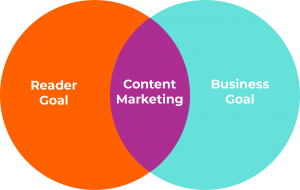What are your Content Marketing Goals (and how can you reach them?)?
We do a lot of content marketing at Pepper Group, and we’re always taking every opportunity to add to our toolkit and get smarter. I recently attended the Ad World Conference, which promotes itself as the World’s Largest Online Advertising Event. Among the many presentations was one from Tyler Hakes, titled The 4 Dimensions of High-Performance Content Marketing Strategies. Some of which Tyler had to say resonated.
An effective content marketing program can play a major role in helping businesses meet their ever-escalating sales objectives. Content marketing can increase authority scores and help companies rank higher in search, putting them at the top of buyer consideration. Content marketing can also position a company as a thought leader, put their products or services on shortlists and make them top of mind and, ultimately, lead to sales. According to Hakes’ framework, there are four distinct goals you should define before you design your content marketing framework. No single content marketing piece (or at least very few) is going to make a significant impact on its own. But every piece of content should fit into a bigger puzzle, and be defined by the following four dimensions.
Strategic Goal
Some companies skip this step, but that’s a mistake. Your content marketing program should have specific goals in place, and each piece of content should be matched against one of them (or two of them, but really, no more than that). That goal might be to help you rank for a specific target keyword. It may be to increase social followers, to generate inbound links, or to convert traffic into leads, or leads into sales. Make sure you measure how well that piece performs on its strategic objective. If it doesn’t excel for that goal, make changes to the content. If it’s effective, how can you repurpose that content?
Tactical Goal
What’s the next, logical step you want the reader to do after they read your piece of content marketing? That next step could be to read another post, download an eBook, follow you on Twitter, click a link, fill out a form or make a phone call. That next step should be clearly mapped out and either obvious to the reader, such as a with a specific CTA, or a natural extension of their reading the piece.
Reader Goal
To make effective content that people want to read, they need to know how it will help them achieve their goals. What’s in it for them? Maybe they may want to learn more about an interesting or important topic. Maybe they want to resolve a problem. Maybe they want to look good at the office or to compare prices. Make sure the content piece hooks the reader by understanding the reader’s intent.
In many ways, the content marketing piece lives in the space where the business goals and reader’s goals overlap.

The Funnel
I almost hate to mention “the Funnel” because at Pepper Group we created our own, much superior alternative called The Revenue Tower®. But for our purposes in this article, we’ll go with the Funnel, which simplistically maps your buyer’s journey from awareness to consideration to decision (or purchase). Ideally, you have content pieces that match each step of that journey and helps buyers move to the next step. If they are in the consideration stage, how can your content marketing piece move your product into their final conversation? If buyers are in the awareness stage, how do you empathize with them, so they know you understand their pain and are ready to consider buying?
Putting it All Together
A robust and detailed content marketing framework can have lots of moving pieces that should be continually analyzed for effectiveness and then tweaked to maximize their effectiveness. When you do, make sure you consider the piece’s strategic and tactical goals, along with the reader’s goals and journey. The effectiveness of your content marketing program will improve by leaps and bounds.
Need to make your content marketing work harder? Let’s talk.

